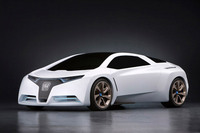Japanese Automakers' Hydrogen Car Drive
TOKYO Oct 25, 2009; Kimiko de Freytas-Tamura writing for AFP reported on Hydrogen cars in Japan. Imagine a car that can be refuelled in minutes but emits only water. Sounds like science fiction? In fact it already exists -- Hollywood star Jamie Lee Curtis has one. So does Honda president Takanobu Ito.
Yet while some see them as the ultimate environmentally-friendly automobiles, the high production cost means that affordable hydrogen-powered fuel-cell cars are still more of a dream than reality.
Manufacturers such as Honda, however, are making a renewed push behind the vehicles, which run on electricity generated by a reaction between hydrogen and oxygen, belching out nothing more harmful than water vapour.
"We believe that the fuel-cell electric vehicle will be the ultimate form for automobiles in the future," Ito said at the Tokyo Motor Show which opened Wednesday.
"It has advantages such as zero CO2 emissions in use, can travel considerable distances without refuelling and can be quickly refuelled," he said.
Honda last year began delivering about 200 FCX Clarity hydrogen-powered cars on lease to US and Japanese customers, including some Hollywood celebrities.
Other automakers have also been pouring money into the technology, invented in the 19th century by the Welsh scientist William Robert Grove.
Toyota, pioneer of hybrids powered by a petrol engine and an electric motor, has said it plans to launch a fuel-cell car by 2015. It is applying its hybrid technology to the vehicles, swapping the petrol engine for a fuel-cell stack.
"We can't concentrate on just one technology," said Takeshi Uchiyamada, the chief engineer of the first-generation Prius hybrid.
Toyota president Akio Toyoda says he expects that eventually electric cars will be used for short distances and fuel-cell hybrids for long journeys.
Nissan and Mazda have developed their own fuel-cell vehicles and leased them to governments and corporate clients, while Suzuki Motor is showcasing a car, a wheelchair and scooter -- all powered by fuel cells -- at the Tokyo Motor Show.
The big challenge for manufacturers is to reduce the production cost of hydrogen-powered vehicles -- currently several hundred thousand dollars each.
"There is a feeling that by 2050 fuel cells will eventually surpass electric cars," said Ashvin Chotai, managing director of Intelligence Automotive Asia.
"In a lot of countries where electricity is generated with fossil fuels electric cars are still not an ideal solution, especially in places like China and India where a lot of the energy is produced using dirty coal," he said.
The goal of carmakers is for hydrogen for cars to be produced by electrolysing water using renewable energy such as solar power.
Fuel cells have long been seen as an eco-friendly alternative to petrol, but for now most automakers are focusing their attention on hybrids and plug-in electric cars.
Supporters, however, see hydrogen-powered cars as the natural next step because they also use electricity but can be refuelled more quickly than plug-in cars and can travel further before the power runs out.
Some industry experts see a day when compact electric cars are used for short distances and fuel cells for bigger vehicles such as trucks, because hydrogen tanks require a lot of space.
As well as the high cost, the lack of filling stations and the size and weight of the fuel-cell vehicles also present hurdles.
Last month, Toyota, Honda, Renault-Nissan, Hyundai, Ford, General Motors, Daimler and Kia issued a joint plea for a sufficient hydrogen infrastructure network to be built by 2015, from when they believe "a few hundred thousand" of the cars could be commercialised worldwide.
The cause got a vital boost last week when the US Congress approved 187 million dollars in funding for research into fuel cells, seen by supporters as the ultimate zero-emission solution.
"There's no way around it. A fuel-cell car gives you power, distance... It gives you short refuelling time," said George Hansen, GM's head of fuel-cell commercialisation in the Asia-Pacific.
"The technology is there and ready to be used. Now it depends on whether governments are willing to put in place the infrastructure, and whether volume production will bring costs down," he told



